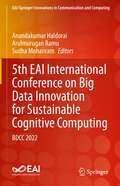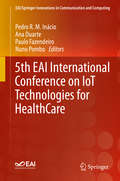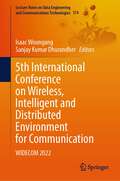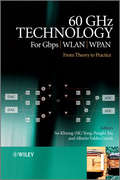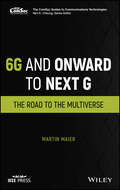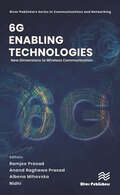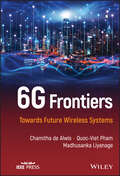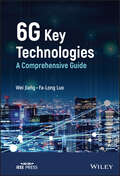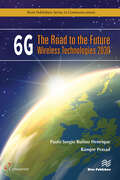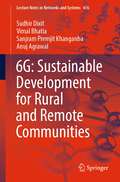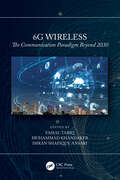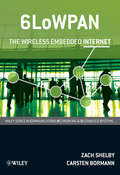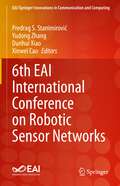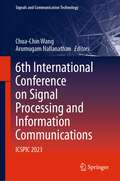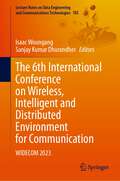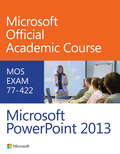- Table View
- List View
5th EAI International Conference on Big Data Innovation for Sustainable Cognitive Computing: BDCC 2022 (EAI/Springer Innovations in Communication and Computing)
by Anandakumar Haldorai Arulmurugan Ramu Sudha MohanramThis book features the proceedings of the 5th EAI International Conference on Big Data Innovation for Sustainable Cognitive Computing (BDCC 2022). The papers feature detail on cognitive computing and its self-learning systems that use data mining, pattern recognition and natural language processing (NLP) to mirror the way the human brain works. This international conference focuses on technologies from knowledge representation techniques and natural language processing algorithms to dynamic learning approaches. Topics covered include Data Science for Cognitive Analysis, Real-Time Ubiquitous Data Science, Platform for Privacy Preserving Data Science, and Internet-Based Cognitive Platform.
5th EAI International Conference on IoT Technologies for HealthCare (EAI/Springer Innovations in Communication and Computing)
by Pedro R. M. Inácio Ana Duarte Paulo Fazendeiro Nuno PomboThis book presents papers from HealthyIoT 2018, the fifth edition of an international scientific event series dedicated to Internet of Things and Healthcare. The papers discuss leveraging a set of existing and emerging technologies, notions and services that can provide many solutions to delivery of electronic healthcare, patient care, and medical data management. HealthyIoT brings together technology experts, researchers, industry and international authorities contributing towards the design, development and deployment of healthcare solutions based on IoT technologies, standards, and procedures. HealthyIoT 2018 is part of the 4th annual Smart City 360˚Summit, promoting multidisciplinary scientific collaboration to solve complex societal, technological and economic problems of emerging Smart Cities. The event is endorsed by the European Alliance for Innovation, an international professional community-based organisation devoted to the advancement of innovation in the field of ICT.Features practical, tested applications in IoT for healthcare;Includes application domains such as eHealth Systems, smart textiles, smart caring environments, telemedicine, wellness, and health management, etc;Applicable to researchers, academics, students, and professionals.
5th International Conference on Wireless, Intelligent and Distributed Environment for Communication: WIDECOM 2022 (Lecture Notes on Data Engineering and Communications Technologies #174)
by Isaac Woungang Sanjay Kumar DhurandherThis book presents the proceedings of the 5th International Conference on Wireless Intelligent and Distributed Environment for Communication (WIDECOM 2022), which took place at the University of Windsor, Windsor, Canada, October 12-14, 2022. The book addresses issues related to new dependability paradigms, design, and performance of dependable network computing and mobile systems, as well as issues related to the security of these systems. The goal of the conference is to provide a forum for researchers, students, scientists and engineers working in academia and industry to share their experiences, new ideas and research results in the above-mentioned areas.
60GHz Technology for Gbps WLAN and WPAN: From Theory to Practice
by Su-Khiong Yong Pengfei Xia Alberto Valdes-GarciaThis book addresses 60 GHz technology for Gbps WLAN and WPAN from theory to practice, covering key aspects for successful deployment. In this book, the authors focus specifically on 60 GHz wireless technology which has emerged as the most promising candidate for multi-gigabit wireless indoor communication systems. 60 GHz technology offers various advantages over current or existing communications systems (e.g. huge unlicensed bandwidth worldwide, high transmit power, high frequency reuse and small form factor), which enables many disruptive applications that are otherwise difficult if not impossible to be realized at lower frequencies. The book addresses all aspects of the state-of-the-art in 60 GHz technology for high data rate wireless applications. Key Features: Comprehensive coverage from theory to practice: provides readers with a thorough technical guide of 60 GHz technology development Brings together the entire area of 60GHz technology for Gigabits per second (Gbps) WLAN and WPAN applications. Discusses practical system designs covering wide aspects such as antenna propagation, beamforming, circuit design, digital communication, signal processing, system architectures, etc. Provides up-to-date standardization activities, regulatory issues, technology development as well as future trends Includes examples and case studies for practical scenarios Contains theoretical, simulation and experimental results to demonstrate and compare the performance of various schemes (or systems) This book serves as an excellent reference for system engineers, system architects, IC designers, standard engineers, researchers, and vendor and manufacturer consumers. Technical consultants, software and application developers will also find this book of interest.
60GHz Technology for Gbps WLAN and WPAN: From Theory to Practice
by Su-Khiong Yong Pengfei Xia Alberto Valdes-GarciaThis book addresses 60 GHz technology for Gbps WLAN and WPAN from theory to practice, covering key aspects for successful deployment. In this book, the authors focus specifically on 60 GHz wireless technology which has emerged as the most promising candidate for multi-gigabit wireless indoor communication systems. 60 GHz technology offers various advantages over current or existing communications systems (e.g. huge unlicensed bandwidth worldwide, high transmit power, high frequency reuse and small form factor), which enables many disruptive applications that are otherwise difficult if not impossible to be realized at lower frequencies. The book addresses all aspects of the state-of-the-art in 60 GHz technology for high data rate wireless applications. Key Features: Comprehensive coverage from theory to practice: provides readers with a thorough technical guide of 60 GHz technology development Brings together the entire area of 60GHz technology for Gigabits per second (Gbps) WLAN and WPAN applications. Discusses practical system designs covering wide aspects such as antenna propagation, beamforming, circuit design, digital communication, signal processing, system architectures, etc. Provides up-to-date standardization activities, regulatory issues, technology development as well as future trends Includes examples and case studies for practical scenarios Contains theoretical, simulation and experimental results to demonstrate and compare the performance of various schemes (or systems) This book serves as an excellent reference for system engineers, system architects, IC designers, standard engineers, researchers, and vendor and manufacturer consumers. Technical consultants, software and application developers will also find this book of interest.
6G and Onward to Next G: The Road to the Multiverse (The ComSoc Guides to Communications Technologies)
by Martin MaierThis book weaves emerging themes in future 6G and Next G networks carefully together. It points to three spheres of contexts with different narratives for the year 2030 and beyond, in which the coming Metaverse as the precursor of the future Multiverse can be embedded naturally. The book aims at providing the reader with new cross-disciplinary research material, ranging from communication and computer science to cognitive science, social sciences, and behavioral economics, for building a deeper Metaverse. It will be instrumental in helping the reader find and overcome some of the most common 6G and Next G blind spots. Modern networks are more than communication and computer science. They may be better viewed as techno-social systems that exhibit complex adaptive system behavior and resemble biological superorganisms. 6G and especially Next G should go beyond continuing the linear incremental 6G=5G+1G mindset of past generations of mobile networks. To this end, the book: Helps readers inquire into new areas of knowledge or understanding that they didn’t have or didn’t pay attention to find their 6G/Next G blind spots Highlights the unique potential benefits of the virtual world for society in that it provides a useful extension of the real-world economy by compensating for its well-known market failures, e.g., rising income inequality Provides a comprehensive description of the original Metaverse vision and highlights the different Metaverse components, applications, open research challenges, and early Metaverse deployment examples from both industry and academia Describes how the Multiverse goes beyond the Metaverse origins and explores the importance of experience innovation since experiences play a central role in the Metaverse Explains Web3 and the emerging field of token engineering and tokenization, i.e., the process of creating tokenized digital twins via programmable tokens, which are viewed as the killer application of Web3 networks for creating technology-enabled social organisms and restoring tech-driven common goods Reviews anticipated 6G paradigm shifts and elaborates on the difference between 6G and Next G research, including Next G Alliance’s audacious goals and their symbiotic relationship between technology and a population’s societal and economic needs Doubles down on the mutually beneficial symbiosis between digitalization and biologization for our possible evolution into future metahumans with infinite capabilities by making us smarter and creating a fundamentally new form of sociality in the Metaverse and Multiverse as well as the future stigmergy enhanced Society 5.0 by leveraging on time-tested self-organization mechanisms borrowed from nature Presents a variety of different concepts of the true nature of reality that bring us closer to the original Metaverse vision and explains how 6G, Next G, and the Metaverse may eventually pave the way to the peak-experience machine that democratizes access to the upper range of human experiences Touches on the possible transition from communication to services beyond communication, most notably the cross-cultural phenomenon of communitas in anthropology and its increasing degrees of perceived connectedness with others, the world, and oneself, given the importance of creating a deep sense of community in the Metaverse Written for students, network researchers, professionals, engineers, and practitioners, 6G and Onward to Next G: The Road to the Multiverse explores the latest Internet developments, with a particular focus on 6G and Next G networks in the context of the emerging Metaverse and future Multiverse as the successors of today’s mobile Internet that has defined the last two decades.
6G and Onward to Next G: The Road to the Multiverse (The ComSoc Guides to Communications Technologies)
by Martin MaierThis book weaves emerging themes in future 6G and Next G networks carefully together. It points to three spheres of contexts with different narratives for the year 2030 and beyond, in which the coming Metaverse as the precursor of the future Multiverse can be embedded naturally. The book aims at providing the reader with new cross-disciplinary research material, ranging from communication and computer science to cognitive science, social sciences, and behavioral economics, for building a deeper Metaverse. It will be instrumental in helping the reader find and overcome some of the most common 6G and Next G blind spots. Modern networks are more than communication and computer science. They may be better viewed as techno-social systems that exhibit complex adaptive system behavior and resemble biological superorganisms. 6G and especially Next G should go beyond continuing the linear incremental 6G=5G+1G mindset of past generations of mobile networks. To this end, the book: Helps readers inquire into new areas of knowledge or understanding that they didn’t have or didn't pay attention to find their 6G/Next G blind spots Highlights the unique potential benefits of the virtual world for society in that it provides a useful extension of the real-world economy by compensating for its well-known market failures, e.g., rising income inequality Provides a comprehensive description of the original Metaverse vision and highlights the different Metaverse components, applications, open research challenges, and early Metaverse deployment examples from both industry and academia Describes how the Multiverse goes beyond the Metaverse origins and explores the importance of experience innovation since experiences play a central role in the Metaverse Explains Web3 and the emerging field of token engineering and tokenization, i.e., the process of creating tokenized digital twins via programmable tokens, which are viewed as the killer application of Web3 networks for creating technology-enabled social organisms and restoring tech-driven common goods Reviews anticipated 6G paradigm shifts and elaborates on the difference between 6G and Next G research, including Next G Alliance's audacious goals and their symbiotic relationship between technology and a population's societal and economic needs Doubles down on the mutually beneficial symbiosis between digitalization and biologization for our possible evolution into future metahumans with infinite capabilities by making us smarter and creating a fundamentally new form of sociality in the Metaverse and Multiverse as well as the future stigmergy enhanced Society 5.0 by leveraging on time-tested self-organization mechanisms borrowed from nature Presents a variety of different concepts of the true nature of reality that bring us closer to the original Metaverse vision and explains how 6G, Next G, and the Metaverse may eventually pave the way to the peak-experience machine that democratizes access to the upper range of human experiences Touches on the possible transition from communication to services beyond communication, most notably the cross-cultural phenomenon of communitas in anthropology and its increasing degrees of perceived connectedness with others, the world, and oneself, given the importance of creating a deep sense of community in the Metaverse Written for students, network researchers, professionals, engineers, and practitioners, 6G and Onward to Next G: The Road to the Multiverse explores the latest Internet developments, with a particular focus on 6G and Next G networks in the context of the emerging Metaverse and future Multiverse as the successors of today’s mobile Internet that has defined the last two decades.
6G Enabling Technologies: New Dimensions to Wireless Communication (River Publishers Series in Communications and Networking)
by Ramjee Prasad Anand Raghawa Prasad Albena MihovskaThe sixth generation of wireless communication (6G), succeeding 5G cellular technology, opens up several possibilities in terms of technology and its offered services. 6G is expected to allow usage of available higher frequency spectrums to cater to increased capacity, throughput, and low latency ( To make this book a fundamental resource, we have invited world-renowned experts in 6G from the industry and academia to pen down their ideas on different aspects of 6G research. The chapters in this book cover a broader scope and various related and unrelated verticals. Specifically, this book covers the following topics: 6G use cases, requirements, and enabling technologies new spectrums and their challenges for 6G privacy preservation in 6G networks aerial infrastructure for 6G networks economic challenges associated with 6G wireless networks. The encompassing intent of this book is to explore the evolution from current 5G networks towards the future 6G networks from a service, air interface, and network perspective, thereby laying out a vision for 6G networks.
6G Enabling Technologies: New Dimensions to Wireless Communication (River Publishers Series in Communications and Networking)
by Ramjee Prasad Anand Raghawa Prasad Albena Mihovska NidhiThe sixth generation of wireless communication (6G), succeeding 5G cellular technology, opens up several possibilities in terms of technology and its offered services. 6G is expected to allow usage of available higher frequency spectrums to cater to increased capacity, throughput, and low latency ( To make this book a fundamental resource, we have invited world-renowned experts in 6G from the industry and academia to pen down their ideas on different aspects of 6G research. The chapters in this book cover a broader scope and various related and unrelated verticals. Specifically, this book covers the following topics: 6G use cases, requirements, and enabling technologies new spectrums and their challenges for 6G privacy preservation in 6G networks aerial infrastructure for 6G networks economic challenges associated with 6G wireless networks. The encompassing intent of this book is to explore the evolution from current 5G networks towards the future 6G networks from a service, air interface, and network perspective, thereby laying out a vision for 6G networks.
6G Frontiers: Towards Future Wireless Systems
by Chamitha de Alwis Quoc-Viet Pham Madhusanka Liyanage6G Frontiers Enables readers to understand the exciting new technologies, architectural directions, technical aspects, and applications of 6G, plus legal and standardization approaches 6G Frontiers offers intelligent insight into the ongoing research trends, use cases, and key developmental technologies powering the upcoming 6G framework. The authors cover a myriad of important topics that intersect with 6G, such as hyper-intelligent networking, security, privacy, and trust, harmonized mobile networks, legal views, and standards initiatives. The work also explores the more extreme and controversial predictions surrounding 6G, such as hyper-connected smart cities, space tourism, and deep-sea tourism. Sample thought-provoking topics covered in the comprehensive work include: Evolution of mobile networks, from 0G to 6G, including the driving trends, requirements, and key enabling technologies of each generation Logistics of 6G networks, which are expected to offer peak data rates over 1 Tbps, imperceptible end-to-end delays (beneath 0.1 ms), and network availability and reliability rates beyond 99.99999% New technology requirements for 6G, such as Further enhanced Mobile Broadband (FeMBB), ultra-massive Machine-Type Communication (umMTC), Mobile BroadBand and Low-Latency (MBBLL), and massive Low-Latency Machine Type communication (mLLMT) Potential architectural directions of 6G, including zero-touch network and service management, intent-based networking, edge AI, intelligent network softwarization, and radio access networks A complete and modern resource for understanding the potential development, logistics, and implications of 6G networks, 6G Frontiers is a must-read reference for researchers, academics, and technology architects who wish to understand the cutting-edge progress that is being made towards better and faster wireless mobile technology.
6G Frontiers: Towards Future Wireless Systems
by Chamitha de Alwis Quoc-Viet Pham Madhusanka Liyanage6G Frontiers Enables readers to understand the exciting new technologies, architectural directions, technical aspects, and applications of 6G, plus legal and standardization approaches 6G Frontiers offers intelligent insight into the ongoing research trends, use cases, and key developmental technologies powering the upcoming 6G framework. The authors cover a myriad of important topics that intersect with 6G, such as hyper-intelligent networking, security, privacy, and trust, harmonized mobile networks, legal views, and standards initiatives. The work also explores the more extreme and controversial predictions surrounding 6G, such as hyper-connected smart cities, space tourism, and deep-sea tourism. Sample thought-provoking topics covered in the comprehensive work include: Evolution of mobile networks, from 0G to 6G, including the driving trends, requirements, and key enabling technologies of each generation Logistics of 6G networks, which are expected to offer peak data rates over 1 Tbps, imperceptible end-to-end delays (beneath 0.1 ms), and network availability and reliability rates beyond 99.99999% New technology requirements for 6G, such as Further enhanced Mobile Broadband (FeMBB), ultra-massive Machine-Type Communication (umMTC), Mobile BroadBand and Low-Latency (MBBLL), and massive Low-Latency Machine Type communication (mLLMT) Potential architectural directions of 6G, including zero-touch network and service management, intent-based networking, edge AI, intelligent network softwarization, and radio access networks A complete and modern resource for understanding the potential development, logistics, and implications of 6G networks, 6G Frontiers is a must-read reference for researchers, academics, and technology architects who wish to understand the cutting-edge progress that is being made towards better and faster wireless mobile technology.
6G Key Technologies: A Comprehensive Guide (IEEE Press)
by Wei Jiang Fa-Long Luo6G Key Technologies An accessible and integrated roadmap to the technologies enabling 6G development In 6G Key Technologies: A Comprehensive Guide, two internationally well-recognized experts deliver a thoroughly original and comprehensive exploration of the technologies enabling and contributing to the development of 6G. The book presents the vision of 6G by reviewing the evolution of communications technologies toward 6G and examining the factors driving that development, as well as their requirements, use cases, key performance indicators, and more. Readers will discover: Thorough introductions to the standardization and technology evolution toward 6G, as well as the vision behind the development of 6G in terms of architectures, algorithms, protocols, and applications. In-depth explorations of full-spectrum wireless technologies in 6G, including enhanced millimeter wave technologies, terahertz-based communications and networking, visible-light and optical wireless communications. Fulsome discussions of smart radio networks and new air interface technologies for 6G including intelligent reflecting surface, cellular massive MIMO, cell-free massive MIMO, adaptive and non-orthogonal multiple access technologies. Perfect for professional engineers, researchers, manufacturers, network operators, and software developers, 6G Key Technologies: A Comprehensive Guide will also earn a place in the libraries of graduate students studying in wireless communications, artificial intelligence, signal processing, microwave technology, information theory, antenna and propagation, system-on-chip implementation, and computer networks.
6G Key Technologies: A Comprehensive Guide (IEEE Press)
by Fa-Long Luo Wei JiangAn accessible and integrated roadmap to the technologies enabling 6G development In 6G Key Technologies: A Comprehensive Guide, two internationally well-recognized experts deliver a thoroughly original and comprehensive exploration of the technologies enabling and contributing to the development of 6G. The book presents the vision of 6G by reviewing the evolution of communications technologies toward 6G and examining the factors driving that development, as well as their drivers, requirements, use cases, key performance indicators, and more. Readers will discover: Thorough introductions to the standardization and technology evolution toward 6G, as well as the vision behind the development of 6G in terms of architectures, algorithms, protocols, and applications. In-depth explorations of full-spectrum wireless technologies in 6G, including enhanced millimeter wave technologies, terahertz-based communications and networking, visible-light and optical wireless communications. Fulsome discussions of smart radio networks and new air interface technologies for 6G including intelligent reflecting surface, cellular massive MIMO, cell-free massive MIMO, adaptive and non-orthogonal multiple access technologies. Perfect for professional engineers, researchers, manufacturers, network operators, and software developers, 6G Key Technologies: A Comprehensive Guide will also earn a place in the libraries of graduate students studying in wireless communications, artificial intelligence, signal processing, microwave technology, information theory, antenna and propagation, system-on-chip implementation, and computer networks.
6G: The Road to the Future Wireless Technologies 2030
by Paulo Sergio Henrique Ramjee PrasadSince the launch of Second-Generation Networks (2G), planning for each future mobile service was initiated many years before its commercial launch. In 2019, 5G Networks begun to be deployed commercially after almost ten years of planning. Similarly, the race for the 6G wireless networks that will be operational in 2030 has already started. To fulfill its potential in the upcoming decade, 6G will undoubtedly require an architectural orchestration based on the amalgamation of existing solutions and innovative technologies. The book will begin by evaluating the state of the art of all current mobile generations' while looking into their core building blocks. 6G implementation will require fundamental support from Artificial Intelligence (AI) and Machine Learning on the network's edge and core, including a new Radio Frequency (RF) spectrum. The 6G use cases will require advanced techniques for enabling the future wireless network to be human-centric, ensuring enhanced quality of experience (QoE) for most of its applications. The concept of Human Bond Communication Beyond 2050 (Knowledge Home) and Communication, Navigation, Sensing, and Services (CONASENSE) will also profit from future wireless communication. Terahertz domains will exploit the ultra-Massive Multiple Input Multiple Output Antennas (UM-MIMO) technologies to support Terabits' data throughputs.Moreover, optical wireless communications (OWC) will also come into play to support indoor and outdoor high-data rates. Further expansion of 6G core entities will support the novel concept of Society 5.0. Quantum computing processing and communications is also likely to be added into the 6G ecosystem with security managed by blockchain orchestration for a robust network.
6G: The Road to the Future Wireless Technologies 2030
by Paulo Sergio Henrique Ramjee PrasadSince the launch of Second-Generation Networks (2G), planning for each future mobile service was initiated many years before its commercial launch. In 2019, 5G Networks begun to be deployed commercially after almost ten years of planning. Similarly, the race for the 6G wireless networks that will be operational in 2030 has already started. To fulfill its potential in the upcoming decade, 6G will undoubtedly require an architectural orchestration based on the amalgamation of existing solutions and innovative technologies. The book will begin by evaluating the state of the art of all current mobile generations' while looking into their core building blocks. 6G implementation will require fundamental support from Artificial Intelligence (AI) and Machine Learning on the network's edge and core, including a new Radio Frequency (RF) spectrum. The 6G use cases will require advanced techniques for enabling the future wireless network to be human-centric, ensuring enhanced quality of experience (QoE) for most of its applications. The concept of Human Bond Communication Beyond 2050 (Knowledge Home) and Communication, Navigation, Sensing, and Services (CONASENSE) will also profit from future wireless communication. Terahertz domains will exploit the ultra-Massive Multiple Input Multiple Output Antennas (UM-MIMO) technologies to support Terabits' data throughputs.Moreover, optical wireless communications (OWC) will also come into play to support indoor and outdoor high-data rates. Further expansion of 6G core entities will support the novel concept of Society 5.0. Quantum computing processing and communications is also likely to be added into the 6G ecosystem with security managed by blockchain orchestration for a robust network.
6G: Sustainable Development for Rural and Remote Communities (Lecture Notes in Networks and Systems #416)
by Sudhir Dixit Vimal Bhatia Sanjram Premjit Khanganba Anuj AgrawalThe book covers a variety of feasible technology options, both wired and wireless, to enable 6G connectivity in rural and remote regions. Along with the enabling technology options, the book also covers important aspects such as human-computer interaction, business models for the local operator ecosystem, regulatory and right-of-way policies, security and privacy, and future challenges related to technology migration, urbanization, and scalability. A special feature of this book is that it covers both the optical and wireless technology aspects to realize 6G connectivity, which will be of interest to a broad range of researchers and practitioners. Detailed figures have been included in the book to cover both the fiber-optics and wireless aspects. These figures include telecommunication equipment and networks ranging from a locality to the under-sea cables to high latitude platforms. The book has simple explanations, pictorial representations, minimal math, and conversational language, which will enable all the readers to grasp it, thereby helping them in decision making and performing comprehensive analysis. This book includes the needs of the unconnected and under-connected sections of the society, notably from the rural and remote areas, when the 6G standards are being discussed and developed. This feature will help overcome the challenge of widening the digital divide from every new generation of mobile network standards. Hence, the book covers all technical and non-technical aspects to be of interest to researchers, decision-makers, academia, social workers, and the readers in technology, growth, and empowerment.
6G Wireless: The Communication Paradigm Beyond 2030
by Faisal Tariq Muhammad Khandaker Imran Shafique Ansari6G Wireless: The Communication Paradigm Beyond 2030 offers a thorough discussion of some key emerging technologies such as Intelligent Reflecting Surface (IRS), Unmanned Aerial Vehicles (UAV), Aerial Computing, Terahertz (THz) Communications, Non-Orthogonal Multiple Access (NOMA) and Rate Splitting Multiple Access (RSMA).The book provides a comprehensive coverage of the vision, requirements, use cases, enabling technologies, and challenges for the future 6G wireless communication systems. This includes discussions on how 6G and future IoT systems will enable extremely low latency healthcare systems, smart industry, haptic communications, programmable wireless environment (PWE), advanced VR/AR and holographic communications. IRS is expected to play a prominent role in 6G and the book thoroughly discusses the role of IRS in enabling physical layer security, UAV communications as well as D2D communications. It also explains channel modeling for IRS enabled PWE.Another key aspect of the book is that it provides a comprehensive discussion on security challenges of emerging 6G systems and their potential solutions. Apart from this, it also explains how blockchain techniques can be used for future IoT applications such as intelligent manufacturing and asset tracking.Written in tutorial style, the book is primarily intended for postgraduate students and researchers in the broad domain of wireless communications as well as research-active academics. The book can also be useful as a reference book for BSc/MSc project/thesis works.
6G Wireless: The Communication Paradigm Beyond 2030
by Faisal Tariq Muhammad Khandaker Imran Shafique Ansari6G Wireless: The Communication Paradigm Beyond 2030 offers a thorough discussion of some key emerging technologies such as Intelligent Reflecting Surface (IRS), Unmanned Aerial Vehicles (UAV), Aerial Computing, Terahertz (THz) Communications, Non-Orthogonal Multiple Access (NOMA) and Rate Splitting Multiple Access (RSMA).The book provides a comprehensive coverage of the vision, requirements, use cases, enabling technologies, and challenges for the future 6G wireless communication systems. This includes discussions on how 6G and future IoT systems will enable extremely low latency healthcare systems, smart industry, haptic communications, programmable wireless environment (PWE), advanced VR/AR and holographic communications. IRS is expected to play a prominent role in 6G and the book thoroughly discusses the role of IRS in enabling physical layer security, UAV communications as well as D2D communications. It also explains channel modeling for IRS enabled PWE.Another key aspect of the book is that it provides a comprehensive discussion on security challenges of emerging 6G systems and their potential solutions. Apart from this, it also explains how blockchain techniques can be used for future IoT applications such as intelligent manufacturing and asset tracking.Written in tutorial style, the book is primarily intended for postgraduate students and researchers in the broad domain of wireless communications as well as research-active academics. The book can also be useful as a reference book for BSc/MSc project/thesis works.
6LoWPAN: The Wireless Embedded Internet (Wiley Series on Communications Networking & Distributed Systems #43)
by Zach Shelby Carsten Bormann"It is stunningly thorough and takes readers meticulously through the design, configuration and operation of IPv6-based, low-power, potentially mobile radio-based networking." Vint Cerf, Vice President and Chief Internet Evangelist, Google This book provides a complete overview of IPv6 over Low Power Wireless Area Network (6LoWPAN) technology In this book, the authors provide an overview of the 6LoWPAN family of standards, architecture, and related wireless and Internet technology. Starting with an overview of the IPv6 ‘Internet of Things’, readers are offered an insight into how these technologies fit together into a complete architecture. The 6LoWPAN format and related standards are then covered in detail. In addition, the authors discuss the building and operation of 6LoWPAN networks, including bootstrapping, routing, security, Internet ingration, mobility and application protocols. Furthermore, implementation aspects of 6LoWPAN are covered. Key Features: Demonstrates how the 6LoWPAN standard makes the latest Internet protocols available to even the most minimal embedded devices over low-rate wireless networks Provides an overview of the 6LoWPAN standard, architecture and related wireless and Internet technology, and explains the 6LoWPAN protocol format in detail Details operational topics such as bootstrapping, routing, security, Internet integration, mobility and application protocols Written by expert authors with vast experience in the field (industrial and academic) Includes an accompanying website containing tutorial slides, course material and open-source code with examples (http://6lowpan.net ) 6LoWPAN: The Wireless Embedded Internet is an invaluable reference for professionals working in fields such as telecommunications, control, and embedded systems. Advanced students and teachers in electrical engineering, information technology and computer science will also find this book useful.
6LoWPAN: The Wireless Embedded Internet (Wiley Series on Communications Networking & Distributed Systems #32)
by Zach Shelby Carsten Bormann"It is stunningly thorough and takes readers meticulously through the design, configuration and operation of IPv6-based, low-power, potentially mobile radio-based networking." Vint Cerf, Vice President and Chief Internet Evangelist, Google This book provides a complete overview of IPv6 over Low Power Wireless Area Network (6LoWPAN) technology In this book, the authors provide an overview of the 6LoWPAN family of standards, architecture, and related wireless and Internet technology. Starting with an overview of the IPv6 ‘Internet of Things’, readers are offered an insight into how these technologies fit together into a complete architecture. The 6LoWPAN format and related standards are then covered in detail. In addition, the authors discuss the building and operation of 6LoWPAN networks, including bootstrapping, routing, security, Internet ingration, mobility and application protocols. Furthermore, implementation aspects of 6LoWPAN are covered. Key Features: Demonstrates how the 6LoWPAN standard makes the latest Internet protocols available to even the most minimal embedded devices over low-rate wireless networks Provides an overview of the 6LoWPAN standard, architecture and related wireless and Internet technology, and explains the 6LoWPAN protocol format in detail Details operational topics such as bootstrapping, routing, security, Internet integration, mobility and application protocols Written by expert authors with vast experience in the field (industrial and academic) Includes an accompanying website containing tutorial slides, course material and open-source code with examples (http://6lowpan.net ) 6LoWPAN: The Wireless Embedded Internet is an invaluable reference for professionals working in fields such as telecommunications, control, and embedded systems. Advanced students and teachers in electrical engineering, information technology and computer science will also find this book useful.
6th EAI International Conference on Robotic Sensor Networks (EAI/Springer Innovations in Communication and Computing)
by Predrag S. Stanimirović Yudong Zhang Dunhui Xiao Xinwei CaoThis book presents the proceedings of the 6th EAI International Conference on Robotics and Networks 2022 (ROSENET 2022). The conference explores the integration of networks and robotic technologies, which has become a topic of increasing interest for both researchers and developers from academic fields and industries worldwide. The authors posit that big networks will be the main approach to the next generation of robotic research, with the explosive number of networks models and increasing computational power of computers significantly extending the number of potential applications for robotic technologies while also bringing new challenges to the networking community. The conference provided a platform for researchers to share up-to-date scientific achievements in this field. The conference took place at Swansea University, Wales, Great Britain.
6th International Conference on Signal Processing and Information Communications: ICSPIC 2023 (Signals and Communication Technology)
by Chua-Chin Wang Arumugam NallanathanThis book presents the proceedings of the 6th International Conference on Signal Processing and Information Communications (ICSPIC 2023), which was held in Singapore, on February 25-27, 2023. The conference aims to provide a leading international forum for researchers, practitioners, and professionals from the industry, academia and government to share their new ideas, progresses and achievements in signal processing and information communications. The contributions focus on the latest advances, trends and future challenges in analog and mixed signal processing, design and implementation of signal processing systems, compressive sensing, machine learning methods for communications and signal processing, multimedia signal processing, natural language processing, next generation mobile communications, nonlinear signal processing, optical communications, parallel and distributed processing, and more.
The 6th International Conference on Wireless, Intelligent and Distributed Environment for Communication: WIDECOM 2023 (Lecture Notes on Data Engineering and Communications Technologies #185)
by Isaac Woungang Sanjay Kumar DhurandherThis book presents the proceedings of the 6th International Conference on Wireless Intelligent and Distributed Environment for Communication (WIDECOM 2023), which took place at Brock University, St. Catharines, Ontario, Canada, October 11-13, 2023. The book addresses issues related to new dependability paradigms, design, and performance of dependable network computing and mobile systems, as well as issues related to the security of these systems. The goal of the conference is to provide a forum for researchers, students, scientists and engineers working in academia and industry to share their experiences, new ideas and research results in the above-mentioned areas.
The 7 Second CV: How to Land the Interview
by James ReedWrite a killer CV and land your dream job. It takes an employer just seven seconds to save or reject a job applicant’s CV. In this book, James Reed – chairman of REED, Britain’s largest recruitment company – offers invaluable and specific advice on what employers want to see in the CVs they receive and how you can stand out from the crowd. Unlike other career development books, the honest advice presented here has been compiled from one-to-one interviews, surveys and countrywide workshops across REED’s network of recruitment consultants. This book is an accessible and enjoyable read, intensely practical and packed with pull-out quotes, layout examples and tips. Find out what future employers are looking for and take the first step to start loving Mondays again.
77-422 Microsoft PowerPoint 2013 (Microsoft Official Academic Course Series)
by Microsoft Official Academic CourseThis Microsoft PowerPoint 2013, Exam 77-422 is the only Microsoft Official Academic Course (MOAC) textbook. This series includes a complete classroom instructional program. The PowerPoint 2013 text is mapped to the PowerPoint 2013 certification exam objectives and is designed to re-enforce workforce skills. With this book students learn to create complex slide shows such as product plans, reports, and marketing materials. Students will learn how to create slide shows based on custom templates generated by others and reuse slides. They will master the creation of slides that include sophisticated data presented in visual formats. They will know how to pause and move back and forth in slide shows, jump to specific slides, drill down to supporting data, mark up slides and much more. PowerPoint 2013 certification can help students with classwork and differentiate job hunters in today’s competitive job market. The Microsoft Official Academic Course (MOAC) Office series also offers OfficeGrader. This valuable tool corrects your students’ tasked-based assignments. Students work on real-world problems like the ones they will encounter in the workforce ensuring they are ready for real professional challenges. OfficeGrader allows for efficient and consistent grading saving time for other important teaching activities. Grading is easier than ever allowing faster assignment turnaround to students.
